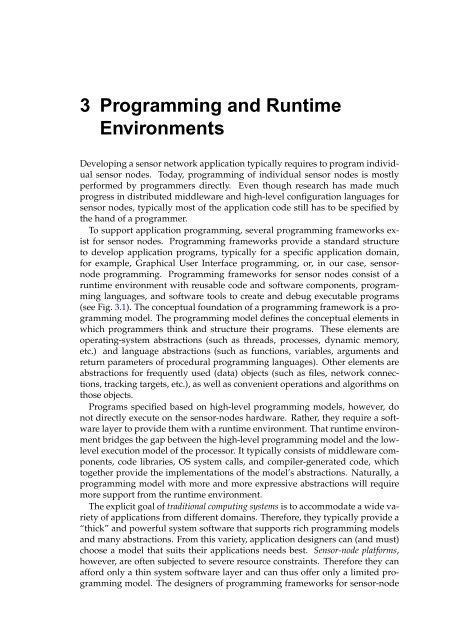A State-Based Programming Model for Wireless Sensor Networks
A State-Based Programming Model for Wireless Sensor Networks
A State-Based Programming Model for Wireless Sensor Networks
You also want an ePaper? Increase the reach of your titles
YUMPU automatically turns print PDFs into web optimized ePapers that Google loves.
3 <strong>Programming</strong> and Runtime<br />
Environments<br />
Developing a sensor network application typically requires to program individual<br />
sensor nodes. Today, programming of individual sensor nodes is mostly<br />
per<strong>for</strong>med by programmers directly. Even though research has made much<br />
progress in distributed middleware and high-level configuration languages <strong>for</strong><br />
sensor nodes, typically most of the application code still has to be specified by<br />
the hand of a programmer.<br />
To support application programming, several programming frameworks exist<br />
<strong>for</strong> sensor nodes. <strong>Programming</strong> frameworks provide a standard structure<br />
to develop application programs, typically <strong>for</strong> a specific application domain,<br />
<strong>for</strong> example, Graphical User Interface programming, or, in our case, sensornode<br />
programming. <strong>Programming</strong> frameworks <strong>for</strong> sensor nodes consist of a<br />
runtime environment with reusable code and software components, programming<br />
languages, and software tools to create and debug executable programs<br />
(see Fig. 3.1). The conceptual foundation of a programming framework is a programming<br />
model. The programming model defines the conceptual elements in<br />
which programmers think and structure their programs. These elements are<br />
operating-system abstractions (such as threads, processes, dynamic memory,<br />
etc.) and language abstractions (such as functions, variables, arguments and<br />
return parameters of procedural programming languages). Other elements are<br />
abstractions <strong>for</strong> frequently used (data) objects (such as files, network connections,<br />
tracking targets, etc.), as well as convenient operations and algorithms on<br />
those objects.<br />
Programs specified based on high-level programming models, however, do<br />
not directly execute on the sensor-nodes hardware. Rather, they require a software<br />
layer to provide them with a runtime environment. That runtime environment<br />
bridges the gap between the high-level programming model and the lowlevel<br />
execution model of the processor. It typically consists of middleware components,<br />
code libraries, OS system calls, and compiler-generated code, which<br />
together provide the implementations of the model’s abstractions. Naturally, a<br />
programming model with more and more expressive abstractions will require<br />
more support from the runtime environment.<br />
The explicit goal of traditional computing systems is to accommodate a wide variety<br />
of applications from different domains. There<strong>for</strong>e, they typically provide a<br />
“thick” and powerful system software that supports rich programming models<br />
and many abstractions. From this variety, application designers can (and must)<br />
choose a model that suits their applications needs best. <strong>Sensor</strong>-node plat<strong>for</strong>ms,<br />
however, are often subjected to severe resource constraints. There<strong>for</strong>e they can<br />
af<strong>for</strong>d only a thin system software layer and can thus offer only a limited programming<br />
model. The designers of programming frameworks <strong>for</strong> sensor-node
















